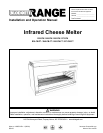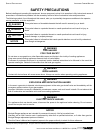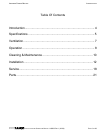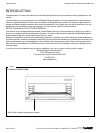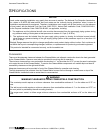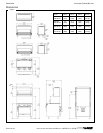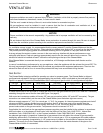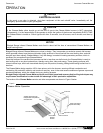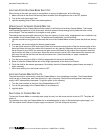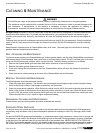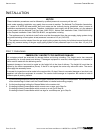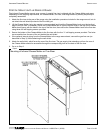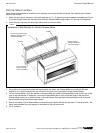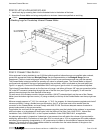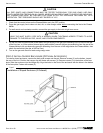
INFRARED CHEESE MELTER OPERATION
INSTALLATION AND OPERATION MANUAL 1186533 REV 1 (02/06) PAGE 7 OF 28
VENTILATION
WARNING
Improper ventilation can result in personal injury or death. Ventilation, which fails to properly remove flue products,
can cause headaches, drowsiness, nausea, or could result in death.
The flue vent, located at the top of the unit, must not be blocked or covered at any time.
All gas appliances must be installed in such a manner that the flow of combustion and ventilation air is not
obstructed. Provisions for adequate air supply must be provided.
NOTICE
Proper ventilation is the owner’s responsibility. Any problem due to improper ventilation will not be covered by the
warranty.
Do not obstruct the front of the Cheese Melter since combustion air enters through this area. Be sure to inspect
and clean the ventilation system according to the ventilation equipment manufacturer’s instructions.
If a ventilation canopy is used, it is recommended that the canopy extend 6" past the Cheese Melter and that the
bottom edge be located 6'6" from the floor. Filters should be installed at an angle of 45° or more from the horizontal.
This position prevents dripping grease and facilitates collecting the run-off grease in a drip pan under the filter.
A strong exhaust fan tends to create a vacuum in the room and may interfere with burner performance or may
extinguish pilot flames. Fresh air openings approximately equal to the fan area will relieve such a vacuum. The
exhaust fan should be installed at least 2" above the vent opening on the top of the Cheese Melter.
If the Cheese Melter is connected directly to an outside flue, a CSA design-certified down draft diverter must be
installed.
In case of unsatisfactory performance by any gas appliance, check the appliance with the exhaust fan turned OFF. Do
this only long enough to check whether doing so corrects any problems with equipment performance. Then turn the
exhaust fan back on and let it run to remove any exhaust that may have accumulated during the test.
GAS SUPPLY
The Cheese Melter is design-certified for operation on natural or propane gases. The Cheese Melter is shipped
configured and adjusted for the type of gas specified by the purchaser, which is indicated on the serial plate (see
Figure 1 on page 4). Connect the Cheese Melter ONLY to the type of gas for which it is configured and adjusted.
Gas Type Total BTU/hour Burner Orifice Pilot Orifice Min. Supply Pressure Manifold Pressure
Natural Gas 40,000 No. 54 (P/N 1008754) 0.055 (P/N 1008754) 7" W.C. 4" W.C.
Propane 40,000 No. 64 (P/N 1008764) 0.036 (P/N 1008764) 11" W.C. 10" W.C.
A model that mounts on the flue riser of a range will have a 3/8" rear gas connection (with a 3/8" male NPT connector)
extending through the rear of the flue riser (see Figure 2 on page 6).
Wall-mount and countertop models will have a 3/8” rear gas connection (with a 3/8” male NPT connector). The gas
connection can extend directly out the rear of the Cheese Melter (near the bottom right-rear corner).
Minimum supply pressure is 7" W.C. for natural gas, 11" W.C. for propane. An internal pressure regulator and shutoff
valve are provided. If using a flexible-hose gas connection, the I.D. of the hose must not be smaller than the
connector on the Cheese Melter, and must comply with ANSI Z21.69. Provide an adequate means of restraint to
prevent undue strain on the gas connection. Test pressure should not exceed 14" W.C.
If applicable, the vent line from the gas appliance pressure regulator must be installed to the outdoors in accordance
with local codes, or in the absence of local codes, with the National Fuel Gas Code, ANSI Z223.1, Natural Gas
Installation Code, CAN/CGA-B149.1, or the Propane Installation Code CAN/CGA-B149.2, as applicable.
An adequate gas supply is imperative. Undersized or low-pressure lines will restrict the volume of gas required for
satisfactory performance. Fluctuations of more than 25% on natural gas or 10% on propane gas will create problems
and affect burner-operating characteristics. A 1/8" pressure tap is located on the manifold to measure the manifold
pressure. The supply line to the Cheese Melter should be no smaller than the inside diameter of the pipe on the
Cheese Melter to which it is connected.



